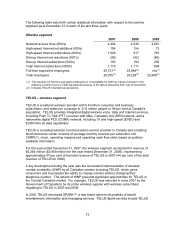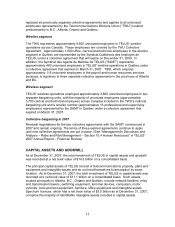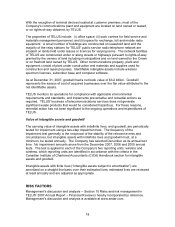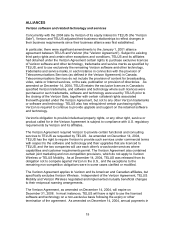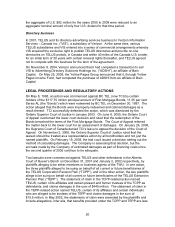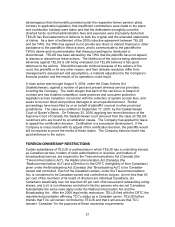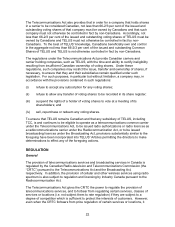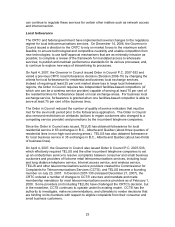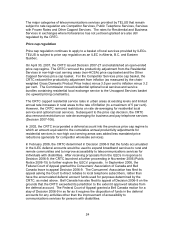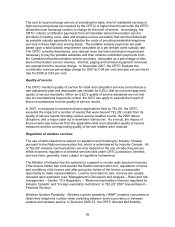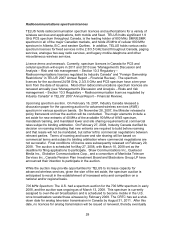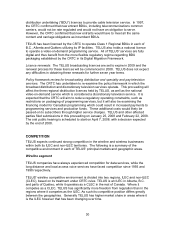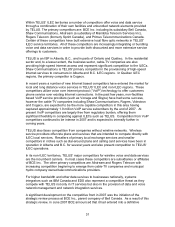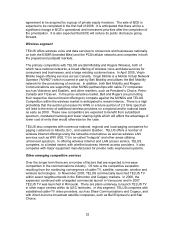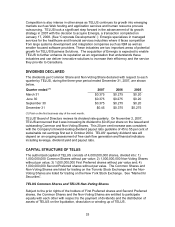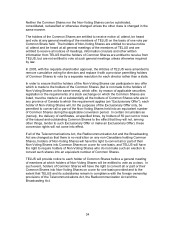Telus 2007 Annual Report Download - page 24
Download and view the complete annual report
Please find page 24 of the 2007 Telus annual report below. You can navigate through the pages in the report by either clicking on the pages listed below, or by using the keyword search tool below to find specific information within the annual report. 24
The major categories of telecommunications services provided by TELUS that remain
subject to rate regulation are Competitor Services, Public Telephone Services, Services
with Frozen Rates and Other Capped Services. The rates for Residential and Business
Services in exchanges where forbearance has not yet been granted are also still
regulated by the CRTC.
Price cap regulation
Price cap regulation continues to apply to a basket of local services provided by ILECs.
TELUS is subject to price cap regulation as an ILEC in Alberta, B.C. and Eastern
Québec.
On April 30, 2007, the CRTC issued Decision 2007-27 and established an open-ended
price cap regime. The CRTC removed the productivity adjustment from the Residential
Services in non-high-cost serving areas (non-HCSA) price cap basket and the Other
Capped Services price cap basket. For the Competitor Services price cap basket, the
CRTC reduced the productivity adjustment from inflation (as measured by the chain-
weighted Gross Domestic Product Price Index) minus 3.5 per cent to inflation minus 3.2
per cent. The Commission moved residential optional local services and service
bundles containing residential local exchange service to the Uncapped Services basket
(no upward pricing constraints).
The CRTC capped residential service rates in urban areas at existing levels and limited
annual rate increases in rural areas to the rate of inflation (to a maximum of 5 per cent).
However, the CRTC removed restrictions on rate de-averaging for residential local
service and optional local services. Subsequent to the price cap decision, the CRTC
also removed restrictions on rate de-averaging for business and pay telephone services
(Decision 2007-106).
In 2002, the CRTC incorporated a deferral account into the previous price cap regime to
which an amount equivalent to the cumulative annual productivity adjustments for
residential services in non-high cost serving areas was added less mandated price
reductions (generally for competitor wholesale services).
In February 2006, the CRTC determined in Decision 2006-9 that the funds accumulated
in the ILEC deferral accounts would be used to expand broadband services to rural and
remote communities and to improve accessibility to telecommunications services for
individuals with disabilities. After receiving proposals from the ILECs in response to
Decision 2006-9, the CRTC launched a further proceeding in November 2006 (Public
Notice 2006-15) to further explore the ILECs’ proposals. In September 2006, the
Federal Court of Appeal granted the Consumers’ Association of Canada and Bell
Canada leave to appeal Decision 2006-9. The Consumers’ Association has filed its
appeal asking the Court to direct rebates to local telephone subscribers, rather than
have the accumulated deferral account funds used for purposes determined by the
CRTC, as noted above. Bell Canada has also filed its appeal of Decision 2006-9 on the
grounds that the CRTC exceeded its jurisdiction to the extent it approved rebates from
the deferral account. The Federal Court of Appeal granted a Bell Canada motion for a
stay of Decision 2006-9 in so far as it requires the disposition of funds in the deferral
accounts for any activities other than the improvement of accessibility to
communications services for persons with disabilities.



